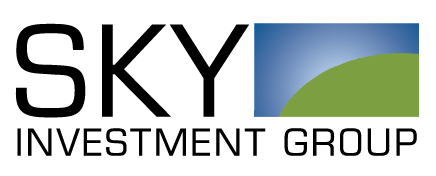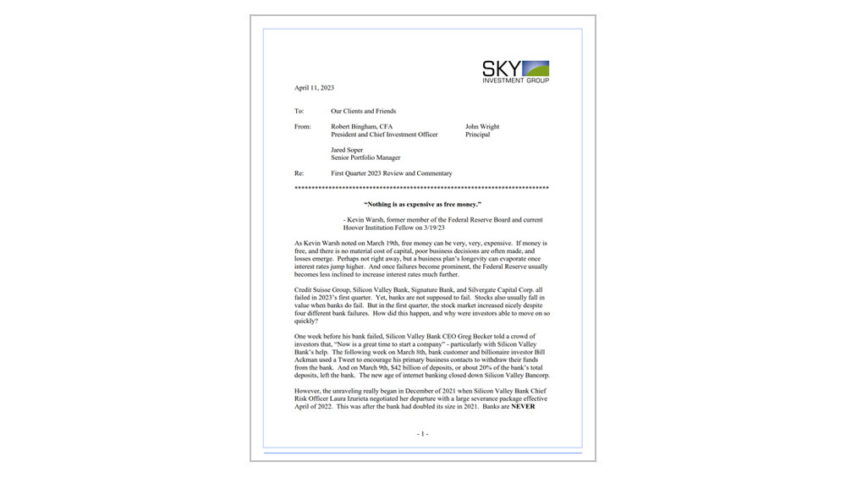View PDF Version of Newsletter
April 11, 2023
Robert Bingham, CFA, President and Chief Investment Officer
John Wright, Principal
Jared Soper, Senior Portfolio Manager
“Nothing is as expensive as free money.”
– Kevin Warsh, former member of the Federal Reserve Board and current Hoover Institution Fellow on 3/19/23
As Kevin Warsh noted on March 19th, free money can be very, very, expensive. If money is free, and there is no material cost of capital, poor business decisions are often made, and losses emerge. Perhaps not right away, but a business plan’s longevity can evaporate once interest rates jump higher. And once failures become prominent, the Federal Reserve usually becomes less inclined to increase interest rates much further.
Credit Suisse Group, Silicon Valley Bank, Signature Bank, and Silvergate Capital Corp. all failed in 2023’s first quarter. Yet, banks are not supposed to fail. Stocks also usually fall in value when banks do fail. But in the first quarter, the stock market increased nicely despite four different bank failures. How did this happen, and why were investors able to move on so quickly?
One week before his bank failed, Silicon Valley Bank CEO Greg Becker told a crowd of investors that, “Now is a great time to start a company” – particularly with Silicon Valley Bank’s help. The following week on March 8th, bank customer and billionaire investor Bill Ackman used a Tweet to encourage his primary business contacts to withdraw their funds from the bank. And on March 9th, $42 billion of deposits, or about 20% of the bank’s total deposits, left the bank. The new age of internet banking closed down Silicon Valley Bancorp.
However, the unraveling really began in December of 2021 when Silicon Valley Bank Chief Risk Officer Laura Izurieta negotiated her departure with a large severance package effective April of 2022. This was after the bank had doubled its size in 2021. Banks are NEVER supposed to double in size without regulatory approval. Nor are banks supposed to operate without a Chief Risk Officer.
Yet in 2022, banking regulators at both the Financial Stability Oversight Council and the Federal Reserve appear to have been as focused on climate change issues as they were on the banking industry’s safety and soundness issues. In its October 2022 Annual Report, the FSOC devoted as much space to climate risk as it did to duration risk. And directly in front of the regulators, Silicon Valley Bank had chosen to make an interest rate bet and mismatch its assets and liabilities.
Yes, there was a run on the bank from depositors, but that would not have occurred if Silicon Valley Bank had maintained its historic focus on hedging risk and disciplined asset and liability controls. Management’s decision to drop such discipline in concert with its extraordinary growth is inexcusable – as is the lack of regulatory action by Silicon Valley Bank’s regulators.
Yes, banking regulators issued six citations warning the bank that it was vulnerable and deficient in governance and controls, but no formal enforcement actions were levied, no memorandum of understanding was issued, and no cease-and-desist order was issued.
Signature Bank also failed from a lack of regulatory enforcement, as did Silvergate Capital, a primary bank for the digital currency industry. These failures all occurred because regulators chose to suggest rather than dictate courses of action. Regulators are empowered to enforce standards, issue operating directives, and mandate management changes when needed. But in these three cases, regulators failed to follow through. The banking industry doesn’t need more laws and directives, it simply needs government officials to do what’s asked of them. Credit Suisse’s problems were also hiding in plain view as this systemically important bank lost money in 5 of the previous 8 years, and in each of the last 3 years.
Fortunately, the heads of the US Treasury, the Federal Reserve, the FDIC, and the Office of the Comptroller of the Currency, agreed to provide industry liquidity and depositor assurance during this March crisis. But these steps were after the fact.
Yet this banking crisis has increased regulatory and industry attention on the safety and soundness of the banking system. Tighter operating practices should be expected along with tighter lending policies that will curtail the future extension of credit. Goldman Sachs estimates that these changes will replicate a 1% or 1.5% increase in interest rates. That means the Federal Reserve has mostly completed its steps to raise interest rates. And while they may raise rates by another 25 basis points in May, that may well be their last increase. The Fed Funds Futures markets also anticipated rate cuts later this year as April began.
Consequently, technology stocks rallied in March and the Nasdaq Composite gained 17% in the first quarter. Ongoing inflationary pressure and continuing job and economic growth could however change the expected direction of interest rates. In turn, growth investors may back away from the market. Such uncertainty may limit the stock market’s upside after the first quarter’s robust returns.
Corporations will also release their earnings results in April and May, which are expected to be 6.8% lower than the results seen in 2022’s first quarter for the S&P 500 companies. Yet for the last few quarters, corporate earnings have beaten expectations. But inflation’s higher prices have reduced sales volumes and increased concerns about an economic slowdown.
Given the growing concerns for a recession, Wall Street analysts, as compiled by FactSet, lowered earnings expectations for first quarter earnings by 6.6% – the largest decline during any one quarter since the second quarter of 2020. FactSet also reported that 16% of the S&P 500 companies had issued earnings warnings for the first quarter while only 5% had increased their earnings guidance for the quarter.
Clearly, material reductions in corporate earnings will make stocks more expensive. Investors will watch corporate profit margins keenly in the first quarter to identify any changes and weaknesses. In 2022’s 4th quarter, profit margins held up better than expected with a 10.9% level recorded for the S&P 500 companies. And while JPMorgan is expecting a 10% profit margin for all of 2023, they do expect profit margins to fall to 9% in 2024. Hence, we may only see a moderate, or slow and steady decline in corporate profits this year.
Investors also have increased concerns about the weakening commercial real estate markets. The National Council of Real Estate Fiduciaries Index of property values declined by 3.5% in 2022’s 4th quarter. That quarterly decline was the largest since 2009. Notably, several multi-billion dollar mortgages for properties in San Francisco and New York defaulted in the first quarter.
Keefe, Bruyette & Woods analyst Jade Rahmani has seen 30% declines in property values in some markets. He also estimated that 40% of the industry’s debt is in floating rate notes, which may require higher rents to cover higher interest rate costs. And BNY Mellon analyst John Velis calculated that 24% of all bank loans in the United States are to the commercial real estate sector. This exposure is another reason banks may slow their growth and reduce their lending activity this year.
The OPEC+ cartel also announced their intention on April 3rd to reduce the amount of oil they produce, and oil prices increased by more than 6% that day. Clearly, higher energy costs could increase world inflation levels, gasoline costs and interest rates. These changes may also increase the likelihood of a recession.
Overall world demand for oil has slowed with greater energy efficiencies in the United States and slower economic growth in China. Other oil producers in Brazil, Nigeria, Guyana, and Iran have also been increasing their output. So, it’s possible that the new price targets set by OPEC+ may not be realized.
Congress also needs to increase the debt ceiling for the United States so our government can issue more bonds to pay for our surging government spending. Republicans in the House of Representatives have submitted proposals to the President and his Administration, but no negotiations have begun thus far. No doubt, the negotiations and compromising process will be unpleasant for all.
So, we expect market volatility to continue as investors vacillate between a risk-on and risk-off trading environment. Every week investors will receive a mix of new data on auto sales, retail spending, housing starts, manufacturing activity, job growth, earnings results, profit margins, and inflation levels that combined will influence Federal Reserve policies and the market’s expectations for interest rate changes. As BlackRock strategist Karim Chedid stated in March, “We’re in an environment where every data point can cause volatility.”
Such uncertainty is nothing new. Markets are always digesting new data and market changes often result. The key is to moderate one’s risk exposure and concentrate on one’s cash flow needs. With attractive dividends and higher bond coupons available, individuals have much more latitude to stay invested, receive income, and keep ahead of inflation. And if the economy does continue to grow, stocks almost always follow suit. The market will continue its fight against its wall of worry, and we will continue our work so investors can maintain their purchasing power.
Do let us know if you have any questions or would like to visit directly.
Securities noted above valued as of the market close on April 10, 2023:
Credit Suisse Group AG – ADR (CS $0.9023)
The Goldman Sachs Group, Inc. (GS $324.96)
JPMorgan Chase & Co. (JPM $127.89)
Signature Bank (SBNY $0.15)
SVB Financial Group (SIVBQ $0.581) – holding company for Silicon Valley Bank
Silvergate Capital Corporation (SI $1.39)
These summary/prices/quotes/statistics contained herein have been obtained from sources believed to be reliable but are not necessarily complete and cannot be guaranteed. Errors and omissions excepted.

